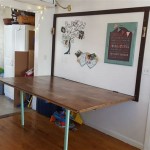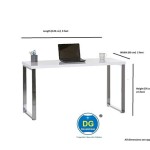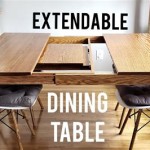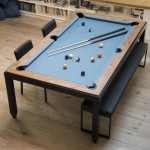Standard Dining Table Size in Centimeters: A Comprehensive Guide
Selecting the appropriate dining table size is crucial for creating a comfortable and functional dining space. The dimensions of a dining table impact the number of people it can comfortably seat, the amount of space available for place settings and serving dishes, and the overall flow of the room. Understanding standard dining table sizes in centimeters allows for accurate planning and informed purchasing decisions. This article provides a comprehensive overview of standard dining table dimensions, factors influencing size selection, and practical considerations for incorporating a dining table into a specific space.
The dining table serves as a central gathering point for meals, conversations, and social interactions within a home or establishment. It is therefore essential to choose a table that not only complements the aesthetic of the space but also adequately accommodates the needs of its users. While tables are available in a wide array of shapes and sizes, understanding standard dimensions serves as a useful starting point in the selection process. These standards are based on human ergonomics and space planning principles, ensuring a comfortable dining experience for all.
Key Point 1: Standard Dining Table Shapes and Dimensions
Dining tables are generally categorized into several common shapes: rectangular, square, round, and oval. Each shape has its own set of standard dimensions that dictate the number of people it can comfortably seat and the amount of space it occupies. Understanding these dimensions is fundamental in selecting the right table for a given space and number of users.
Rectangular Dining Tables: Rectangular tables are among the most popular choices due to their versatility and ability to accommodate a large number of people. Standard widths for rectangular dining tables typically range from 90 cm to 120 cm. This width provides sufficient space for place settings and serving dishes in the center of the table. The length of the table varies depending on the desired seating capacity. A table length of 150 cm can comfortably seat six people (three on each side), while a length of 180 cm can seat eight (four on each side). Tables exceeding 210 cm are generally required to seat ten or more people comfortably. Specifically, a 240 cm long table can often accommodate up to ten individuals, with the potential for twelve with tighter spacing. For larger gatherings, tables extending to 300 cm or beyond are available, but these require significant room dimensions to avoid overcrowding.
Square Dining Tables: Square dining tables are well-suited for smaller spaces and intimate gatherings. They are often used to seat four people. A standard square dining table typically measures between 90 cm x 90 cm and 120 cm x 120 cm. A 90 cm table provides minimal space, while a 120 cm table offers a more comfortable dining experience with ample room for place settings and a modest centerpiece. Square tables larger than 120 cm become less practical for standard dining rooms and may be better suited for specific design applications.
Round Dining Tables: Round tables promote conversation and create a sense of intimacy. The diameter of a round table determines its seating capacity. A table with a diameter of 90 cm can comfortably seat four people. A diameter of 120 cm can accommodate four to six people, depending on plate sizes and serving arrangements. To seat six to eight people, a diameter of 150 cm to 180 cm is generally required. Round tables with diameters exceeding 180 cm are less common in residential settings due to the substantial space they occupy.
Oval Dining Tables: Oval dining tables offer a compromise between the linear efficiency of rectangular tables and the conversational benefits of round tables. They are typically slightly narrower than rectangular tables of comparable length to allow for easier passage around them. Standard widths range from 90 cm to 120 cm, similar to rectangular tables. The length varies depending on the seating capacity, typically following the same guidelines as rectangular tables for accommodating specific numbers of diners. For example, an oval table 180 cm in length and 100 cm in width can comfortably seat eight people.
Key Point 2: Factors Influencing Dining Table Size Selection
Selecting the appropriate dining table size extends beyond simply knowing the standard dimensions. Several factors must be considered to ensure that the chosen table fits the space, accommodates the intended number of users, and meets specific functional requirements.
Room Size and Shape: The dimensions and configuration of the dining room are paramount in determining the appropriate table size. A large room can accommodate a larger table, while a smaller room necessitates a more compact design. It is crucial to measure the available space accurately, taking into account doorways, walkways, and other furniture. As a general guideline, allow at least 90 cm of clearance space around the table to facilitate comfortable movement and prevent overcrowding. Consider the shape of the room; for instance, a long, narrow room may be better suited for a rectangular table, while a square room may benefit from a square or round table.
Seating Capacity: The number of people who will regularly use the dining table is a primary consideration. Consider both everyday use and occasional gatherings. If the table is primarily used by a small family, a smaller table may suffice. However, if frequent entertaining is anticipated, a larger table or a table with extendable leaves may be necessary. Overestimating the seating requirements can lead to wasted space and a cluttered dining area, while underestimating can result in cramped and uncomfortable dining experiences.
Dining Style: The style of dining also influences table size selection. Formal dining requires more space for place settings, serving dishes, and elaborate centerpieces. Informal dining, on the other hand, may require less space. If the table is frequently used for buffet-style meals, additional surface area may be needed to accommodate serving platters and utensils. Consider the overall aesthetic and functional requirements of the dining experience when determining the appropriate table size.
Table Base and Leg Placement: The design of the table base and the placement of the legs can impact the usable space underneath the table and the comfort of the diners. Tables with pedestal bases provide more legroom than tables with traditional legs. However, pedestal bases may limit the seating capacity at the corners of the table. If the table has legs, ensure that they are positioned in a way that does not obstruct legroom for those seated around the table. The placement of the legs should also be considered when determining the appropriate chair width and spacing.
Key Point 3: Practical Considerations and Ergonomics
Beyond the dimensions and influencing factors, certain practical and ergonomic considerations contribute to the overall dining experience. Paying attention to these details can enhance comfort and usability.
Table Height: Standard dining table height typically ranges from 71 cm to 76 cm. This height is generally considered optimal for comfortable dining for individuals of average height. However, individuals with significantly different heights may require adjustments to the chair height to maintain proper posture and prevent discomfort. It is important to consider the relationship between table height and chair height to ensure that diners have sufficient legroom and can comfortably reach the table.
Chair Height: Standard dining chair seat height is typically between 43 cm and 48 cm. This height allows for comfortable legroom under the table. There should be approximately 25 cm to 30 cm of space between the seat of the chair and the underside of the table. This spacing ensures that diners have ample room to move their legs and avoid feeling cramped. When selecting chairs, consider the armrest height as well. Armrests should be low enough to fit comfortably under the table when the chair is pushed in.
Elbow Room: Adequate elbow room is essential for comfortable dining. Each diner should have approximately 60 cm of personal space at the table. This spacing allows for comfortable arm movements and prevents diners from bumping elbows with their neighbors. When planning the seating arrangement, ensure that there is sufficient space between chairs to provide each diner with adequate elbow room. This consideration is particularly important for formal dining settings where diners may be using multiple utensils and larger plates.
Material and Construction: The material and construction of the dining table also impact its durability and stability. Solid wood tables are generally more durable and longer-lasting than tables made of composite materials. However, solid wood tables can be more expensive and require more maintenance. The construction of the table should be sturdy and stable, ensuring that it does not wobble or shake during use. Examine the joints and connections to ensure that they are well-made and secure. The finish of the table should be durable and resistant to stains and scratches.
Careful consideration of these factors, in conjunction with the standard dining table sizes in centimeters, ensures a well-informed and practical approach to selecting a dining table that perfectly suits the needs of the space and the individuals who will use it. Taking the time to plan and measure accurately will ultimately lead to a more comfortable, functional, and aesthetically pleasing dining area.
Optimal Sizes For The Dining Room Kitchen Furniture Urban Quarter

Dining Table Dimensions Measurements

A Guide To Choosing The Ideal Dining Table Width

Useful Standard Dimensions For Home Furniture Engineering Discoveries Dining Table Sizes Design

How To Choose The Right Dining Table Size Kaplan Furniture

How Do I Choose The Right Size Of Solid Wood Dining Table Set For My S Picket Rail Custom Furniture Interiors
What Is The Standard Size Of An 8 Seater Dining Table Quora

What Is The Ideal Dining Table And Chair Height

Dining Table Height Chair

Revit Family Rectangular Dining Tables Post Digital Architecture








